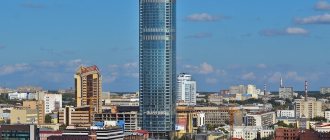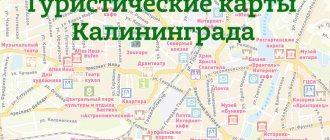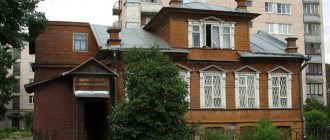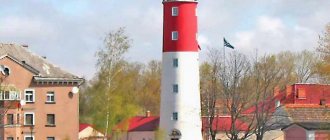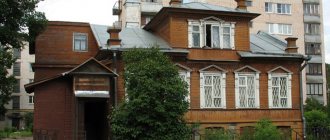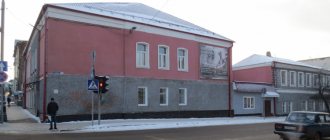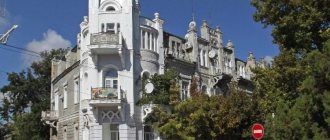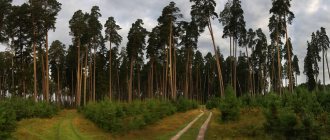City of Kaliningrad
Kaliningrad is a city in western Russia and the administrative center of the Kaliningrad region, located on the shores of the Baltic Sea on the Pregolya River. In the past it was known as the city of Königsberg - the capital of East Prussia and one of the most important centers of the Baltic. Kaliningrad has a rich history and a unique flavor for Russia, full of sights and architectural monuments. Even though the city lost its historical appearance during the Second World War, it retained the “atmosphere of old Europe.”
Kaliningrad is the westernmost administrative center of Russia, which for most of its history was one of the most important cities in Prussia, so it stands out historically and culturally for its “European” mentality. Unfortunately, the Second World War practically destroyed the architecture of old Königsberg, leaving very little of its former beauty. Architecturally, today's Kaliningrad is a mixture of late German buildings and buildings predominantly from the Soviet period.
Despite all this, Kaliningrad has several unique attractions: Kant Island, where an impressive medieval cathedral is located, a silent witness to the centuries-old history of the city, near the walls of which the great German philosopher rests, several beautiful neo-Gothic city gates, ancient German churches and small surviving quarters of historical buildings. Kaliningrad is also an excellent starting point for visiting the famous Baltic beaches and other interesting places in the Kaliningrad region.
Amber Museum
The country's only amber museum is located in the Don Tower of the Königsberg Fort. The exhibition consists of several parts and is located on three floors. The natural science department has collected various amber samples - pieces of fossilized resin with insects and plants aged 45-50 million years. Among them is the largest sun stone in Russia and the second largest in the world, weighing 4 kg 280 g. It was found in the village of Yantarny, where the Kaliningrad Amber Factory is located.
Amber Museum, Kaliningrad
Another exhibition presents products made from Baltic gemstones: sculptures, interior items, icons, portraits, boxes, cups, jewelry. Notable is the Faberge cigarette case made of amber, made in 1913. Some exhibits are elaborate copies of original masterpieces, for example, fragments of the lost Amber Room. Among them is the world’s largest mosaic painting made of amber - the decorative panel “Rus”. On the ground floor of the tower there is an exhibition of amber products by contemporary authors.
To learn more about the extraction and industrial processing of amber, it is worth going to the village of Yantarny to the amber factory. Here you can see the quarry where sunstone is mined and find your own piece of resin in the sand.
Address:
pl. Marshala Vasilevsky, 1., Kaliningrad
Operating mode:
May - September - from 10:00 to 19:00, seven days a week, October - April - from 10:00 to 18:00, Monday - closed.
Guides: Russia
Moscow
Saint Petersburg
May be interesting: Other cities in Russia
Zoo
The Kaliningrad Zoo is one of the three oldest zoos in Russia, along with Moscow and St. Petersburg.
It was opened in 1896. During the Great Patriotic War, fierce battles took place here, after which only four animals survived. In the post-war period, the enclosures were again filled with animals, redevelopment was carried out on the territory, and a children's playground was set up. Today it is one of the favorite vacation spots of city residents. Kaliningrad Zoo
The zoo contains more than 2 thousand species of animals - from Baltic seals to giraffes. One of the long-lived elephants is Pregolya, named after the city river. She was born in 1970. The zoo is also famous for its arboretum, where you can see magnolia, rhododendron, and sakura blooming. The best way to learn more about the zoo's inhabitants and history is to take a tour, which takes place every Sunday.
Address:
Mira Avenue, 26, Kaliningrad.
Operating mode:
daily from 9:00 to 19:00. Tickets can be purchased online. Tours are held on Sundays at 11:00.
Geography and climate
Kaliningrad is located on the Pregolya River at its confluence with the Kaliningrad Bay of the Baltic Sea. The city is the capital of the westernmost administrative-territorial unit of Russia - the Kaliningrad region, located between Poland (Gdansk) and Lithuania (Klaipeda). The distance from Kaliningrad to Moscow is approximately 1300 km.
Winter in Kaliningrad
The climate of Kaliningrad is transitional from maritime to continental. It is characterized by relatively high humidity and unpredictable weather, typical of most Baltic cities. Summers in Kaliningrad are usually cool, and winters are mild with slight frosts and unstable snow cover.
Curonian Spit
The Curonian Spit is a unique creation of nature that almost all tourists coming to the Kaliningrad region strive to see. A national park has been created on its territory; the Curonian Spit is the only site in the region included in the UNESCO World Heritage List.
The length of the sand spit is 98 km, part of the territory belongs to Lithuania. On the spit you can admire forests, dunes, and lakes. Swim in the Curonian Lagoon or the sea, sunbathe on sandy beaches. The world's first ornithological station, Fringilla, is located here. The migratory route of birds heading to Africa and Southern Europe for the winter runs through the Curonian Spit.
Story
Around the 10th century, the settlement of Tvangste was founded at the mouth of the Pregolya River to protect the waterways. The year of foundation of the city is considered to be 1255, when the Teutonic knights founded a castle on the site of this Prussian settlement, named Königsberg or Krolevets (in Polish). By the end of the 13th century, a new settlement had grown up around the castle and was granted city rights.
Interestingly, other settlements began to form around the castle - Löbenicht and Kneiphof (now Kant Island), which also received city rights. Later, they united into one city, which they called Königsberg. At the same time, the original Königsberg began to be called simply Altstadt.
Center of Kaliningrad
In the first half of the 14th century, construction of a cathedral began on the island of Kneiphof. In the 15th century, the capital of the Teutonic Order was moved to Königsberg from Marienburg (now Malbork in Poland). In 1466, the city became the capital of the Prussian Duchy as part of the Polish kingdom. Königsberg was also part of the Hanseatic League.
Koenigsberg was the center of science and culture in Germany, Poland and Lithuania. In 1724, Immanuel Kant, one of the most famous German philosophers, who lived in this city all his life, was born here. In 1776, the famous writer Amadeus Hoffmann was also born in Königsberg.
Königsberg was part of Poland until 1657. In 1758, the city was taken by Russian troops and for some time belonged to the Russian Empire, until Peter III returned it to Prussia. In the 19th century, Königsberg quickly grew and developed, becoming one of the centers of Germany. In 1919, one of the first airports in Europe was built here.
Fishing village and Kanta island
Unfortunately, historic Königsberg was practically destroyed during the Second World War. In 1944, the city was first bombed by British aircraft, and then severely damaged as a result of a heavy assault by Soviet troops. At the same time, many iconic sights of Königsberg were destroyed, including the ancient castle. In 1946, the city was renamed Kaliningrad in honor of the famous communist figure Mikhail Kalinin.
Historical and Art Museum
The museum is located in the former Stadthalle building, an architectural monument of the 20th century.
This museum presents everything about Kaliningrad - from history to natural features. The funds store natural science, art and other collections - almost 140 thousand exhibits. The exhibition tells about the times when the city was part of Prussia and how it was taken by Soviet troops. The museum includes a bunker museum and Fort No. 5. Historical and Art Museum
Address:
st. Klinicheskaya, 21, Kaliningrad.
Operating mode:
every day from 10:00 to 18:00, closed on Mondays.
How to get there
Kaliningrad has an airport, which is located 16 km northeast of the city. From the airport to the center you can take bus 144 or taxi. Kaliningrad is connected by air to Moscow, St. Petersburg, Kazan, Minsk, Warsaw and some other cities.
Baltic Sea
You can get to Kaliningrad by train from Moscow, St. Petersburg, Vilnius, Sochi, and by bus from Tallinn, Riga, Kiel, Lubeck, Gdansk, Pärnu, Berlin and Szczecin.
Swan Lake
The picturesque Swan Lake, surrounded by an alder forest, is located on the Curonian Spit at the foot of the Olenya dune and is its decoration. A narrow strip of sand separates the lake from the Curonian Lagoon.
The lake is home to swans, ducks, and herons.
Attractions
The main attraction of modern Kaliningrad is the cathedral and Kant Island. In addition, here you can see several magnificent ancient gates and German churches. In Soviet times, Kaliningrad was built up with typical high-rise buildings, with surviving fragments of historical buildings adjacent to them. Significant areas of pre-war German architecture have been preserved only in Amalienau, Ratshof and Maraunenhof (in fact, these are suburbs of Königsberg, where cottages of wealthy citizens were built in the 19th and early 20th centuries).
Kant Island (Kneiphof)
Kant Island
Kant Island or Kneiphof is one of the oldest places in Kaliningrad. In the Middle Ages, a settlement arose here, which soon received city rights, and then became part of Königsberg. The island now houses the city's most iconic landmark, the cathedral. The grave of the famous philosopher Immanuel Kant is also located here.
Once upon a time this island, formed by the Pregolya branches, was the real heart of Königsberg. Kneiphof was the spiritual and commercial center of the city, built up with three hundred houses. The island was connected to the rest of Königsberg by five bridges. Kneiphof was destroyed in 1944 by British air raids. After Kaliningrad became part of the USSR, the ruins of buildings were removed to rebuild Leningrad.
Cathedral
The Cathedral is a symbol of modern Kaliningrad. It was built in the 14th century in the brick Gothic style. It was originally a Catholic Church, which became Lutheran after the Reformation. Currently, the cathedral is not a functioning religious building and is used for museum exhibitions and concerts. Unfortunately, the rich interior of the church was destroyed by bombing. But the building itself survived. During Soviet times, the cathedral was in a deplorable state and was completely restored only in the 2000s.
Many believe that the cathedral was preserved only thanks to Kant’s grave. Kant's works were highly appreciated by Lenin. Therefore, during Soviet times, the ruins of the ancient church, located next to the grave of the great philosopher, were decided to be left alone.
The first cathedral in Königsberg was built by 1302 and was located in the southwestern part of Altstadt. Very quickly it became too small for the growing city. Ultimately, the Master of the Teutonic Order allocated a site for the construction of a new cathedral on the island of Kneiphof. And in 1333 construction began. The building material for the new church building was brick obtained from the demolition of the old cathedral. Also for the construction, new gates were made within the walls of Alstadt and a temporary bridge was built. Interestingly, the Cathedral Gate eventually stood for 6 centuries and was destroyed by bombing in 1944. The new cathedral was completed in 1380.
Opposite Kant Island, on the banks of the Pregolya, there is the “Fish Village” - a modern complex of buildings in the style of traditional German architecture. This stylized “piece” of old Königsberg is now a popular attraction in Kaliningrad.
Königsberg city gate
In Kaliningrad, 7 city gates have survived to this day. All of them were built in the 19th century and are now important architectural monuments.
Brandenburg Gate
The Brandenburg Gate was built in the 17th century on the road leading to Brandenburg Castle. The current building, in brick neo-Gothic style, dates from the first half of the 19th century and is located on the border of the historic district of Haberberg. The gate is still used for its intended purpose.
Royal Gate
The Royal Gate was built in Kaliningrad in the 19th century on the site of the medieval Kalthof Gate, which was demolished in the first half of the 18th century. They resemble a small castle and are a striking example of neo-Gothic architecture. The Royal Gate is decorated with bas-reliefs of King Otakar II of Bohemia (left), King Frederick I of Prussia (center) and Duke of Prussia Albrecht I (right), installed in three niches. Nowadays a branch of the Museum of the World Ocean is located here.
Friedland Gate
Friedland Gate is another brick neo-Gothic landmark of Kaliningrad, dating back to the 19th century. Nowadays the museum of old Königsberg is located here.
Rossgarten Gate
The Rossgarten Gate was built in the second half of the 19th century on the site of the first fortified ramparts of Königsberg, dating back to the 17th century. They have beautiful battlements and small neat turrets. Now there is a restaurant here.
Friedrichsburg Gate
The Friedrichsburg Gate is a powerful fortification built in 1852 in the neo-Gothic style. Now within these walls there is a branch of the Museum of the World Ocean.
Sackheim Gate
The Sackheim Gate was built in the mid-19th century and for some time served as a checkpoint at the entrance to the city. Moreover, the first gate on this site was erected back in the 17th century and was part of the old fortified ramparts.
Don Tower
The Don Tower is part of the surviving 19th century fortifications that houses the Amber Museum. This powerful fortification forms a single architectural ensemble with the Rossgarten Gate. During the assault on Königsberg, the garrison of this tower was the last to surrender.
Churches of Kaliningrad
Cathedral of Christ the Savior
Cathedral of Christ the Savior is an Orthodox cathedral, which is the architectural dominant of Victory Square. The temple was consecrated in 2006 and built in the traditional Russian-Byzantine style. It is topped with six domes and a belfry.
Juditten
Juditten is a Gothic church founded in the second half of the 13th century by the Teutonic Knights. This is the oldest (surviving) building in Kaliningrad. Now it is part of an Orthodox convent.
Queen Louise Memorial Church
The former Church of Queen Louise is a neo-Romanesque historical building with Art Nouveau elements, built at the beginning of the 20th century. Originally there was a Lutheran church here. Nowadays there is a puppet theater within its walls.
Ponart
Ponart is a neo-Gothic brick church built at the end of the 19th century. Since 1992 it has been an Orthodox Church of the Nativity of the Blessed Virgin Mary.
Former Church of the Holy Family
The former Church of the Holy Family is a beautiful neo-Gothic building built at the beginning of the 20th century according to the design of Friedrich Heitmann. In 1945, the church was seriously damaged and was practically in ruins until the 80s of the 20th century. Restored in 1982 as the city philharmonic.
Holy Cross Cathedral
Holy Cross Cathedral is an Orthodox church located in the building of a former Lutheran church. This Art Nouveau building was built in the 40s of the 20th century.
Church of St. Adalbert
St. Adalbert's Church is a small neo-Gothic chapel built at the beginning of the 20th century in Amalienau. Now there is an administrative building here, which belongs to the Institute of Terrestrial Magnetism
Other sights and interesting places in Kaliningrad
Victory Square
Victory Square is one of the central squares of Kaliningrad, which was previously called Hanseatic. Until the beginning of the 20th century, city fortifications were located in its place.
For tourists with children, the local zoo is a great place to visit. The zoo in Kaliningrad is one of the oldest and largest in Russia. It was founded in the 19th century. There are more than 300 species of animals here. For botany lovers, we recommend going to the botanical garden, where 2,500 species of plants from various places on the planet are collected.
Königsberg Stock Exchange
Königsberg Stock Exchange is one of the most beautiful civil buildings of modern Kaliningrad, built on the banks of the Pregolya in the second half of the 19th century in the neo-Renaissance style.
The Curonian Spit is one of the most beautiful natural attractions of the Kaliningrad region. This narrow strip of land with sand dunes, pine forests and wonderful sea views stretches from Zelenogradsk to Klaipeda, Lithuania.
Synagogue
The New Synagogue is a Jewish religious building built in 2018 on the site of an older 19th-century synagogue that was destroyed during World War II.
Museum of the World Ocean
The Museum of the World Ocean is one of the most interesting museums in Kaliningrad, which is entirely dedicated to the sea. Ships and deep-sea vehicles, equipment and finds recovered from the seabed are presented here.
Amalienau
Amalienau is a former suburb of Königsberg, which before World War II was built up with villas for wealthy citizens. Significant areas of historical buildings have been preserved here to this day. This is one of the most atmospheric places in modern Kaliningrad.
Museum of the World Ocean
The museum complex is dedicated to the inexhaustible riches of the world's oceans.
The complex includes the main building and separate museum ships on the Pregolya embankment, as well as branches in different parts of the city. A submarine, a fishing trawler, a seaplane, a space communications vessel - it’s worth spending a whole day to inspect all the vessels. Be sure to visit the legendary research ship "Vityaz", on which scientists from different countries studied the ocean for many years. It was from it that the depth of the Mariana Trench was first measured. Today there is a museum on the ship and a boat is open - you can spend the night in the cabins in which members of scientific expeditions lived. World Ocean Museum ship
The main building of the museum complex houses aquariums with marine life, the Mir-1 deep-sea submersible and the skeleton of a sperm whale, one of the largest in Russia. Nearby, a new building of the Planet Ocean museum in the form of a large glass ball is being built. One of the branches of the museum, the Maritime Exhibition Center, is located in Svetlogorsk. It contains an ethnographic collection dedicated to the people of the sea, and also has a gallery of artistic works on a maritime theme.
Address:
Peter the Great embankment, 1, Kaliningrad.
Operating mode:
main building - every day from 10:00 to 18:00, closed on Mondays.
Konigsberg Cathedral
Nearby is the main tourist location - Kant Island and the Königsberg Cathedral.
Concerts are held almost daily in the cathedral, including mini organ concerts that can be attended during the day. Perhaps Kaliningrad is the best place to reflect on the categorical imperative, since it is Kant's hometown. The philosopher is buried right there, near the walls of the cathedral.
What else: if the evening is not conducive to philosophy, you can go on the “Party-weekend in Kaliningrad” tour.
View this post on Instagram
Posted by Viktoras Kiaulakis (@viktorasfoto)
Locks
Where can lovers of antiquity and adventure go for one day from Kaliningrad? Visit medieval castles that have been preserved in different parts of the Kaliningrad region. Many centuries ago, fortifications were built for the knights of the Teutonic Order.
To see Waldau, Schaaken, Tapiau and the ruins of other ancient castles, we recommend taking an individual tour or renting a car.
Schaaken Castle. Photo: Sergey S. Petrov / wikimedia.org / CC BY-SA 4.0.
First photo: arturkornakov / unsplash.com.
Friedland Gate Museum
Another museum dedicated to the pre-war life of the inhabitants of Königsberg, from the Middle Ages to the mid-20th century.
There are 7 permanent exhibitions available to visitors. The museum contains household items, clothing, toys, and signs that help you imagine the life of city residents in different periods. All visitors are shown a holographic film with old photographs of the city. The museum is located in the Friedland Gate - this is one of the seven city gates that have survived to this day. Friedland Gate
Address:
st. Dzerzhinsky, 30, Kaliningrad.
Operating mode:
from May to August - from 10:00 to 19:00, from September to April - from 10:00 to 18:00, seven days a week.

